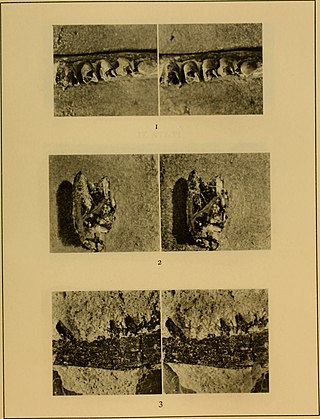
Ctenacodon is a genus of extinct mammal that lived in what is now North America during the Upper Jurassic period. It is a member of the family Allodontidae within the order Multituberculata. Ctenacodon, also known as Allodon, was named by Othniel Charles Marsh in 1879. At least three species are currently recognized.
Psalodon is an extinct genus of North American mammal that lived during the Upper Jurassic period. It's a member of the family Allodontidae within the order Multituberculata.
Zofiabaatar is a genus of extinct mammal from the Upper Jurassic period. It was a relatively early member of the extinct order Multituberculata within the suborder "Plagiaulacida". It lived in North America along with dinosaurs such as Diplodocus and Allosaurus.

Dryosaurus is a genus of an ornithopod dinosaur that lived in the Late Jurassic period. It was an iguanodont. Fossils have been found in the western United States and were first discovered in the late 19th century. Valdosaurus canaliculatus and Dysalotosaurus lettowvorbecki were both formerly considered to represent species of Dryosaurus.

The Tendaguru Formation, or Tendaguru Beds are a highly fossiliferous formation and Lagerstätte located in the Lindi Region of southeastern Tanzania. The formation represents the oldest sedimentary unit of the Mandawa Basin, overlying Neoproterozoic basement, separating by a long hiatus and unconformity. The formation reaches a total sedimentary thickness of more than 110 metres (360 ft). The formation ranges in age from the late Middle Jurassic to the Early Cretaceous, Oxfordian to Hauterivian stages, with the base of the formation possibly extending into the Callovian.

The Morrison Formation is a distinctive sequence of Late Jurassic sedimentary rock that is found in the western United States, which has a wide assortment of taxa represented in its fossil record, including dinosaur fossils in North America. It is composed of mudstone, sandstone, siltstone and limestone and is light grey, greenish gray, or red. Most of the fossils occur in the green siltstone beds and lower sandstones, relics of the rivers and floodplains of the Jurassic period.
Amphidon is an extinct genus of Late Jurassic mammal from the Morrison Formation. It is present in stratigraphic zone 5. The only species in the genus is Amphidon aequicrurius, found by Simpson in 1925.
Aploconodon is an extinct genus of Late Jurassic mammals belonging to the family Amphidontidae. It contains one species, A. comoensis.
Trioracodon is an extinct genus of Late Jurassic to Early Cretaceous eutriconodont mammal found in North America and the British Isles. It was named in 1928
Comodon is an extinct genus of Late Jurassic mammal from the Morrison Formation of Wyoming. Fossils of this taxon are present in stratigraphic zone 5.
Tinodon is an extinct genus of mammal alive 155–140.2 million years ago (Oxfordian-Berriasian) which has been found in the Morrison Formation, the Alcobaça Formation (Portugal) and the Lulworth Formation (England). It is of uncertain affinities, being most recently recovered as closer to therians than eutriconodonts but less so than allotherians. Two species are known: T. bellus and T. micron.
Amblotherium is an extinct genus of Late Jurassic and Early Cretaceous mammal. The type species Amblotherium pusillum is from the Lulworth Formation of southern England, while the referred species Amblotherium gracile is from stratigraphic zones 2, 3 and 5 of the Morrison Formation of the US.
Tathiodon is an extinct genus of Late Jurassic mammal from the Morrison Formation. Present in stratigraphic zone 5.

Laolestes is an extinct genus of dryolestid mammal. Fossil remains are known from the Morrison Formation, in stratigraphic zones 5 and 6., the Late Jurassic of Portugal, and Early Cretaceous Wadhurst Clay of the United Kingdom.

Dryolestes is an extinct genus of Late Jurassic mammal from the Morrison Formation and the Alcobaça Formation of Portugal. The type species Dryolestes priscus is present in stratigraphic zones 2, 5, and 6.
Comotherium is an extinct genus of Late Jurassic mammal from the Morrison Formation. Present in stratigraphic zone 5.
Euthlastus is an extinct genus of Late Jurassic mammal from the Morrison Formation. Present in stratigraphic zones 5 and 6. It is represented by only five upper molars.

Opisthias is a genus of sphenodont reptile. The type species, Opisthias rarus, is known from the Late Jurassic (Kimmeridgian-Tithonian) Morrison Formation of western North America, present in stratigraphic zones 2 and 4–6.

Paurodontidae is a family of Late Jurassic to Early Cretaceous mammals in the order Dryolestida. Remains of paurodontids have been found in the United States, Britain, Portugal, and Tanzania. The group likely represents a paraphyletic group of basal non dryolestid dryolestidans. Paurodon has been suggested to have been a specilast feeder on earthworms due to the morphology of its teeth closely resembling that of the golden mole genus Amblysomus.

Brancatherulum is an extinct genus of Late Jurassic mammal from the Tendaguru Formation of Lindi Region of Tanzania. It is based on a single toothless dentary 21 mm in length. It is currently considered either a stem-zatherian or dryolestidan.













